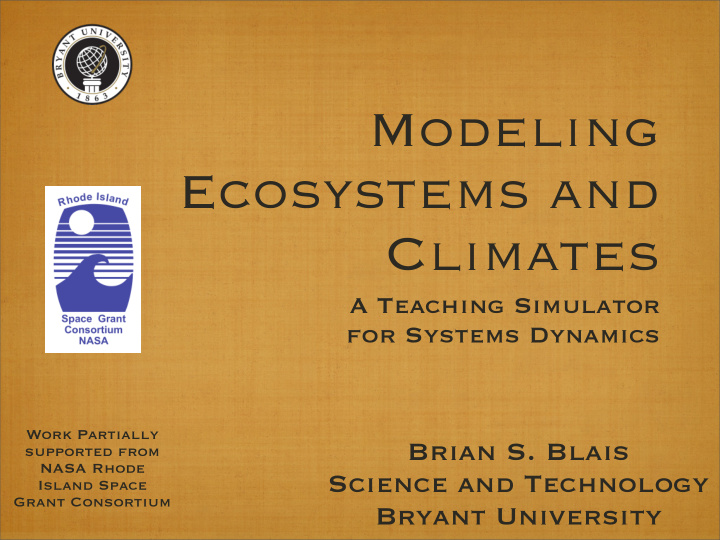



Modeling Ecosystems and Climates A Teaching Simulator for Systems Dynamics Work Partially Brian S. Blais supported from NASA Rhode Science and Technology Island Space Grant Consortium Bryant University
Introducing Systems Stock and flow Diagrams d (mice) = + b (mice) − d (mice) dt differential mice ′ = + b (mice) − d (mice) equations = 1 . 1 b = 0 . 08 d
Current Tools Spreadsheet Excel, Numbers, Google Spreadsheet Graphical Stella, Powersim, Vensim, Simile
Current Tools Spreadsheet Graphical
Spreadsheet Pros Cons Students already Does not Scale Familiar Well Students Write the Equations can get Simulation Itself Messy Numerical Instabilities
Current Tools Spreadsheet Graphical
Graphical Programs Pros Cons Nice Interface for Commercial Simple Systems Cumbersome with Learning Curve Large Systems Not extensible
Cumbersome
Python Easy language nasa, google free scientific computing support ode support
The Simulator
Equations And Flows Specify either Full equations... ...or Inflows/ Outflows to Stocks
Predator-Prey r · deer 2 /K r · deer Births Deer Deaths c · deer · wolf D · deer · wolf Births Wolf Deaths W d · wolf
Predator-Prey
Kermack-McKendrick Infectious Disease Model
Coffee Cup Model Newton’s Law of Cooling Energy Balance
Coffee Cup Model
Coffee Oscillations
Coffee Oscillations
Coffee Oscillations Analogy with Earth Surface Temperatures Noon 3PM
Daisyworld Model White daisies Black daisies Available fertile land
Daisyworld Model
Daisyworld Model
Daisyworld Model Solar Input doubles over this time
Higher-Order
Future directions Better user interface 2-D, 3-D, N-D equations Thanks! Work Partially supported from NASA Rhode Island Space Grant Consortium
Recommend
More recommend